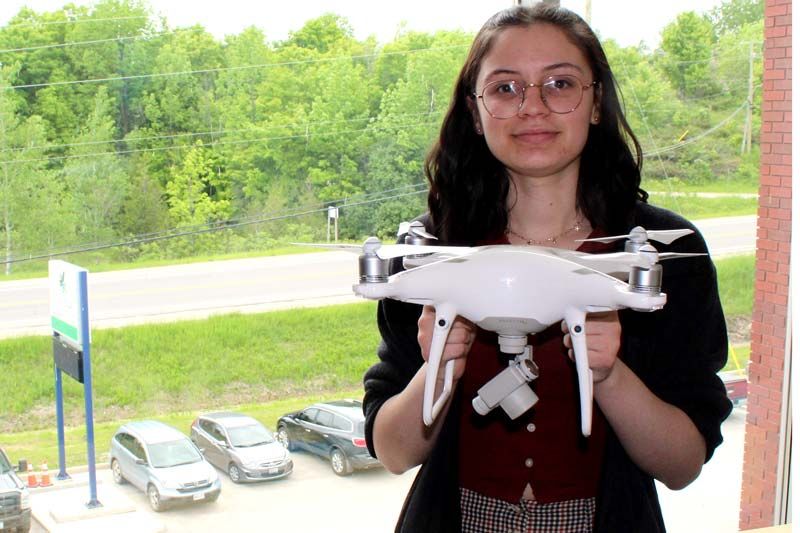Craig Bakay | Jun 12, 2019
While many area high school students are scrambling this time of year to find a summer job, GREC Grade 11 student Ryleigh Rioux already has hers all lined up — and what a summer job it is.
Rioux, who recently received her drone pilot’s licence (via geography/biology teacher Wade Leonard’s innovative and unique program at GREC), will be mapping Malcolm and Ardoch Lakes from the air thanks to a grant North Frontenac Township and the lake association managed to secure specifically for the project.
“We’ll be using the drone to collect aerial imagery,” she said. “They’ll be putting down burlap on the milfoil beds and we’ll track the results.
“We’ll be creating a baseline data set which is exciting because there hasn’t been much work done in this area as yet.”
She said planning will perhaps be the biggest part of her job.
“Flying over water and collecting video data is difficult because of the reflection and refraction,” she said. “I’ll be controlling the take off and landing of the drone but the computer does much of in-flight deployment.”
Leonard said the actual mapping will be very dependent on weather.
“It will take time,” he said. “Cloud cover is obviously a big issue.
“We can deal with ripples and even some whitecaps but the atmosphere can present problems.”
So can the fact that water creates refraction and reflection issues but Leonard thinks they’ve come up with a solution for most of those.
“We’ll be using polarizing optics to refine the features,” he said. “That will take several flights to orient the drone properly.”
And the project has attracted the attention of Carleton University professor Jesse Vermaire.
“Our job is to provide the baseline data so we can show the year-to-year incremental growth of the milfoil,” he said. “We can get down 15-20 feet from the surface and provide 3D data which will link up with the Carleton information well.”
He said that they can get detail that scuba divers and boat-side sonar devices can’t.
“We can look at the health of the entire weed bed, and measure the results if under attack by weevils,” he said. “But we have to get out there and grab the data.”
He said they’ve already done some work and it’s led to observations that boats going through the beds can help spread the milfoil as “it spreads through fragmentation.”
He’s optimistic there will be solutions found but “those are things we’ll have collect all the data to know.”
For example, he said, the life cycle of the northern milfoil weevil, which eats milfoil, may provide some answers.
“The weevils may overwinter in shoreline duff (vegetative cover) as much as 18 feet from the water,” he said. “And the weevils are a favorite food of sunfish and others.”
For Rioux, the prospects are exciting. She said she’d like to pursue a career designing environmentally friendly and sustainable building but many of the techniques they’ll be pioneering could shape the future of lake ecology and data collection.
“The ability to shape a new course,” she said. “How can you pass that up?”
More Stories
- Dry Conditions Spark Fires in Fields and Forests
- 143rd Maberly Fair
- Local Seniors Medal at OSGA 55+ Provincial Games
- Seventh Town Serenades Sharbot Lake
- Brass Point Bridge Closure Leaves Commuters Behind
- Wild Art Walk Call For Submissions
- Three Dwelling Limit Coming For Lots in North Frontenac
- Wildfire in the 1000 block of Rutledge Road - Township Says Fire Now "Under Control"
- Verona and Sydenham Ballpayers Win National Championship With Kingston Colts
- Sweet Music and Some hard Truths At Blue Skies MusicFestival

